Building a kitchen is an ideal option for some homeowners. It allows you to customize everything from the ground up. Consider your design tastes and culinary needs to create the kitchen of your dreams.
However, there is one important factor to consider when building a kitchen - cost. Building a kitchen is expensive. Costs vary depending on the design, material, location, and other factors but you can expect it to be quite an investment either way.
Homeowners who are aware of costs and design options can get creative and design a kitchen that works with their budget, home, and culinary needs. Here are some factors to think about.
Key Factors Influencing Kitchen Build Costs
Several factors will influence your kitchen build costs. Here are some to consider.
Size and Layout of Your Kitchen
The size of your kitchen will impact different aspects of pricing. For example, flooring cabinets and countertops are typically priced on a square footage basis. The more you need, the more you will pay. Contractors will also charge more to paint bigger kitchens.
The layout of the kitchen also matters. If you have a simple kitchen layout, it will be easy to install appliances and flooring and move things in and out. A more complex design, such as a U-shaped or L-shaped floor plan, can make processes labor-intensive and may increase costs.
A preinstalled kitchen island is another item contractors may need to work around. They may charge more for the added hassle.
So how much will size impact cost? According to a Forbes report:
- Small Kitchen remodels are between $12,000 and $22,000
- Medium kitchen remodels are between $22,000 and $46,000
- Large kitchen remodels are between $42,000 and $60,500
Quality of Finishes and Materials
The quality of your finishes and materials will impact cost. For example, if you purchase an upscale material like granite for your countertops, it will be much more expensive than laminate. Similarly, you can invest in upscale hardwood flooring or save money with vinyl. Wood cabinets are typically a more expensive and preferred choice, but MDF or particleboard may be more suited to designers on a budget.
Bear in mind that many money-saving options will cost you more in the long run. For example, laminate may not be as expensive as wood, but it also won’t last as long. You may end up spending more money on repairs and replacement costs.
Labor Costs and Location
Labor costs and location will also impact costs. As mentioned before, contractors may charge more if they are working with a layout that makes installation difficult. They also may increase costs if they work with materials that are heavy or challenging to install.
Your location also makes a difference. If you live in a location with a high cost of living, you will pay more for your kitchen build. People in areas with low living costs are likely to spend less on remodeling.
Contractor expertise is another cost-related factor. An experienced contractor will charge more than a newbie. However, the added expense may be worth it as experienced workers will work quicker and know how to deal with unexpected incidents.
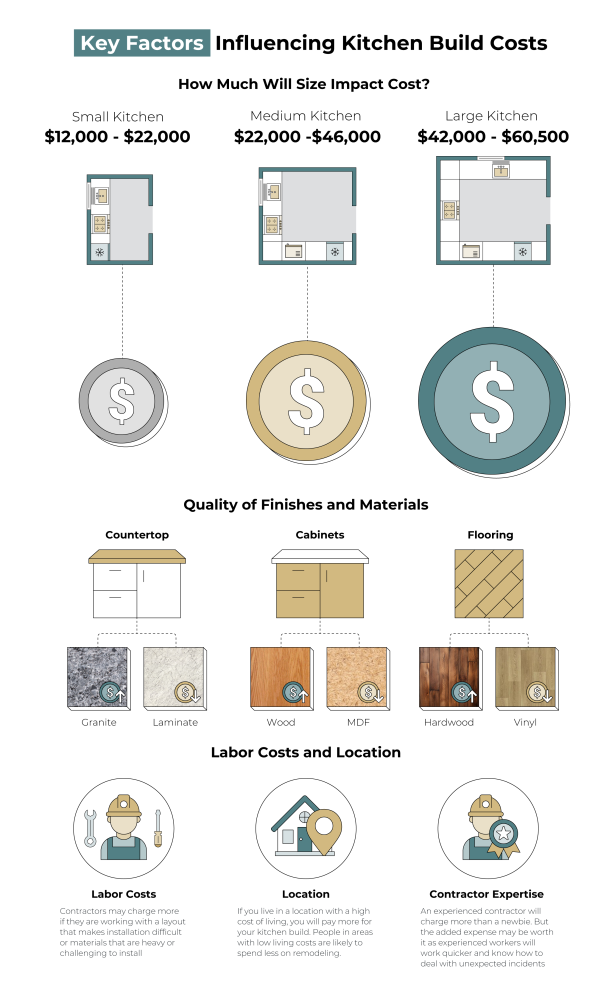
Breakdown of Kitchen Costs
In this section, we’ll take a deeper dive into cabinets, countertops, flooring, and other kitchen fixtures so you can determine how they contribute to expenses.
Cabinets
Solid wood cabinets stand out for their unique characteristics and durability. However, they are typically the most expensive cabinets you can buy costing between $50 and $150 per square foot.
Laminate, particle board, and MDF are less expensive options. While inexpensive, they offer versatile design options. They also add up to savings typically costing closer to $15 per square foot.
You may also pay more if you customize your cabinets. Depending on the extent of the customization, these personalized details can increase costs by thousands of dollars. However, you can save money by opting for semi-custom cabinetry or in-stock options.
Countertops
Countertop price is typically affected by size, finish, and installation. Contractors charge by square footage, so the more countertop space you require the more you pay. Installation of heavy materials will also increase costs as will luxury finishes.
For more insight, here are some finish choices and their cost brackets.
- Granite is typically at the upper range of countertop costs generally adding $40 to $100 per square foot to your kitchen build expenses. However, these cabinets are attractive and highly durable.
- Quartz is another durable and aesthetically pleasing cabinet choice costing between $50 and $200 per square foot.
- Laminate is a more affordable option costing $20 to $80 per square foot. It may be customized to imitate various natural stone materials. However, it may not last as long.
Flooring
In terms of flooring, you may consider luxury hardwood or more affordable laminate. Laminate flooring can mimic the look of real wood, but it won’t provide quite the same aesthetic, nor will it last as long.
You will generally pay between 79 cents and $3 per square foot for laminate flooring. Hardwood flooring costs closer to $6.40 per square foot on average including installation.
Be aware that material costs aren’t the only thing to factor in. Wood is also heavier and harder to install than laminate. This is part of what makes it the more expensive option.
Appliances
Appliances will also add to costs. Here are the average costs of some of the essentials.
- Fridge: $500-$2000
- Stove: $600-$1300
- Dishwasher: $400-$1200
Here are some factors that will impact the cost of your appliances:
- Luxury Features: These include smart features and other amenities like an ice dispenser on a refrigerator.
- Brand Name: You will pay more for an appliance from a well-known brand as compared to a no-name.
- Design Options: Manufacturers may charge more for appliances that feature interesting colors and design options.
- Energy Efficiency: Energy-efficient appliances may cost more upfront, but they will save you money in the long run.
- Durable Construction: Be aware of appliances with prices that seem too good to be true. They may not be durable.
Lighting and Fixtures
Lighting and fixtures must also be considered in the budget. Lighting generally costs between $100 and $200 per fixture but prices can vary wildly depending on the fixture type. Homeowners can choose from pendant lighting, overhead lighting, recessed lighting, undercabinet lighting…and the list goes on.
Kitchen sinks are another fixture with a wide cost range. CopperSmith estimates sinks can cost between $60 and $2000. However, prices will vary depending on the size, configuration, number of basins, material, brand, and construction.
Plumbing and Electrical Work
Even if you install a kitchen in a home with existing electrical and plumbing systems, you may require renovations due to different configurations or additional loads. If your system is old, you may simply decide to replace it while the contractors are available. Electrical labor can cost between $2000 and $5000 while plumbing can cost between $3000 and $10,000.
Be aware that there are often complications when contractors work on interior systems. They can determine they need more materials than they originally thought, or they may find the job is more labor-intensive than they predicted. Add some wiggle room into your budget to account for these expenses.
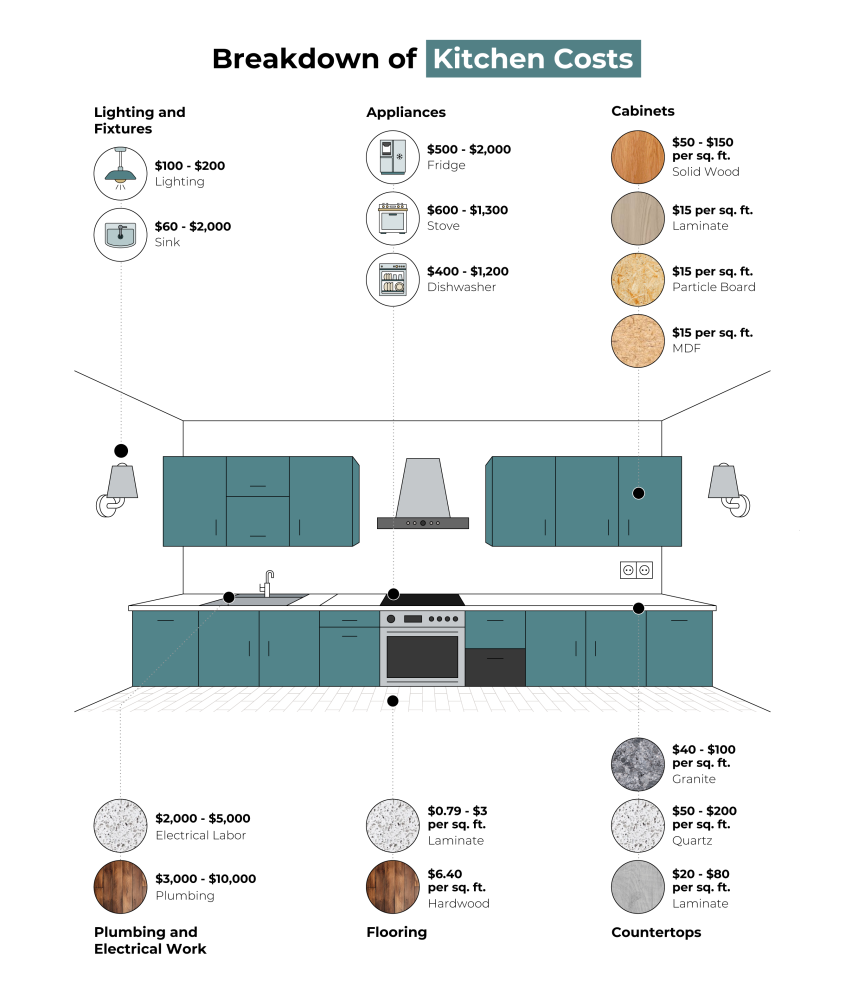
Additional Costs to Consider When Building a Kitchen
When homeowners embark on a kitchen build, they often consider how much they will spend on fixtures and design elements, but there are several underlying costs they may not think about. Here are a few that may make your project more expensive than you anticipated.
Permits and Inspections
You may require permits for electrical and plumbing remodeling which will add to expenses. Permits generally are not more than a few hundred dollars, but they can add up. You may also have to pay a plan check and inspector fees.
Fees vary depending on how where you live, but permit costs may total about $300, inspector fees are typically between $300 and $500, and plan checks can cost $50 to $70.
In addition to adding to expenses, it can take a while for permits to come through and inspections to be completed. It could cause your project to drag out timewise.
Structural Changes
You may not realize the need for structural changes when you initially order your kitchen design. However, a contractor may identify a need for them when they begin assessing your project. They may determine you need to knock down walls or reconfigure your plumbing or electrical systems.
Other costs may be more predictable. For example, you may decide you want to add a kitchen island or open a wall. Regardless, these projects are quite labor intensive and will increase costs considerably.
Delivery and Shipping Fees
Anyone who has ordered anything online understands the pain of sticker shock after delivery or shipping fees are added. Imagine how painful it can be when you order large items like appliances and flooring.
Fortunately, you can reduce these costs by sourcing locally. If you purchase goods from a local store, delivery fees will not be as steep. You may even be able to pick up the items yourself.
Bulk purchasing may also save you money. For example, instead of purchasing your fridge from one company and your oven from another company, buy both from one provider. You may save on shipping and delivery.
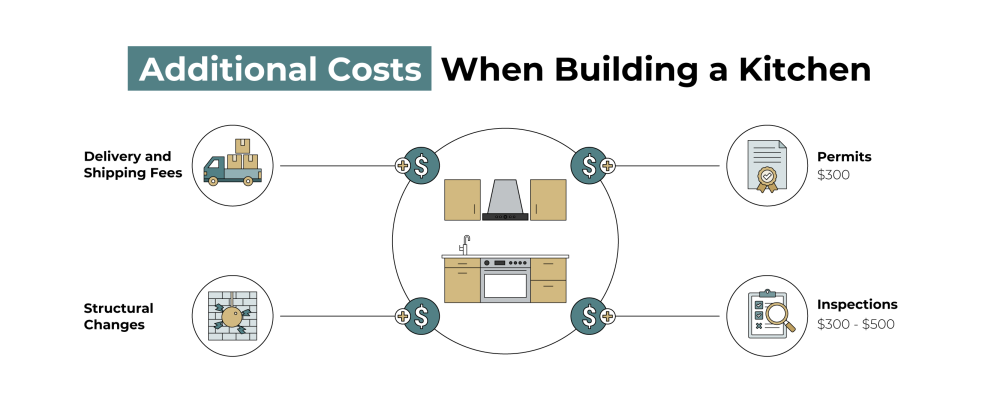
Average Kitchen Build Costs Based on Size and Style
As previously mentioned, kitchen build expenses are directly related to the size of your kitchen. The style also matters. If you purchase high-end appliances, expensive finishing materials, and top-tier paints, your remodeling project will be more expensive.
Here are some costs to consider.
Small Kitchen- Between 100-150 sq. Feet
- High-End Remodel: $22,000
- Budget Remodel: $12,000
Medium Kitchen- Between 150-250 sq. Feet
- High End Remodel: $46,000
- Budget Remodel: $22,000
Large Kitchen- 250+ sq. feet
- High-End Remodel: $60,5000
- Budget Remodel: $42,000
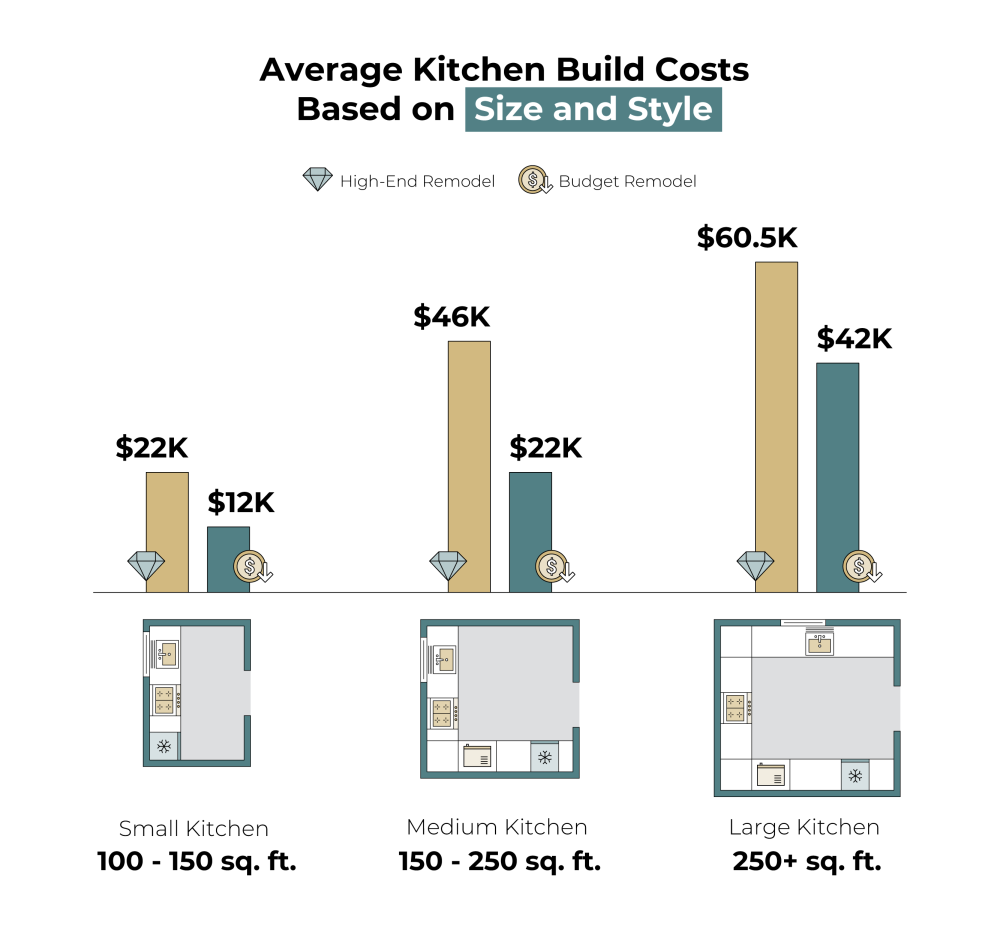
Tips to Save Money When Building a Kitchen
Building a kitchen is not cheap, but there are some shortcuts you can take to lower kitchen remodeling costs without sacrificing quality. Here are some to consider.
Opt for Stock Cabinets
Custom cabinets may seem ideal. You can order the perfect finishes, specific hardware, personalized storage solutions, soft-close hinges, door glides, and much more. However, these customizations can add hundreds of dollars to your expenses.
A stock cabinet will be much less expensive and just as high quality. You could also compromise by limiting the extent of customizations you choose.
DIY Some Aspects of the Build
You may also DIY some aspects of the build to save money. For example, you may handle the painting or demolition. You can even pick up items yourself to save on shipping and delivery costs.
When determining which projects you can DIY, don’t bite off more than you can chew. If you take on projects you can’t handle, you may injure yourself, perform faulty installations, or need to rent materials you don’t have. If you’re not careful, it could cost you more in the long run.
Compare Quotes from Different Contractors
Don’t go with the first contractor you speak to. Get quotes from different contractors to ensure you get the lowest price. You may even use quotes as leverage by asking contractors to beat their competitor’s prices.
When comparing quotes, consider what’s included. For example, some contractors may include permits in their estimates while others do not. Some may offer delivery in their services while others charge extra for it.
You should also consider the contractor's reputation, whether they offer warranties, their timeline, and their communication skills. Ensure you are getting value for your money.
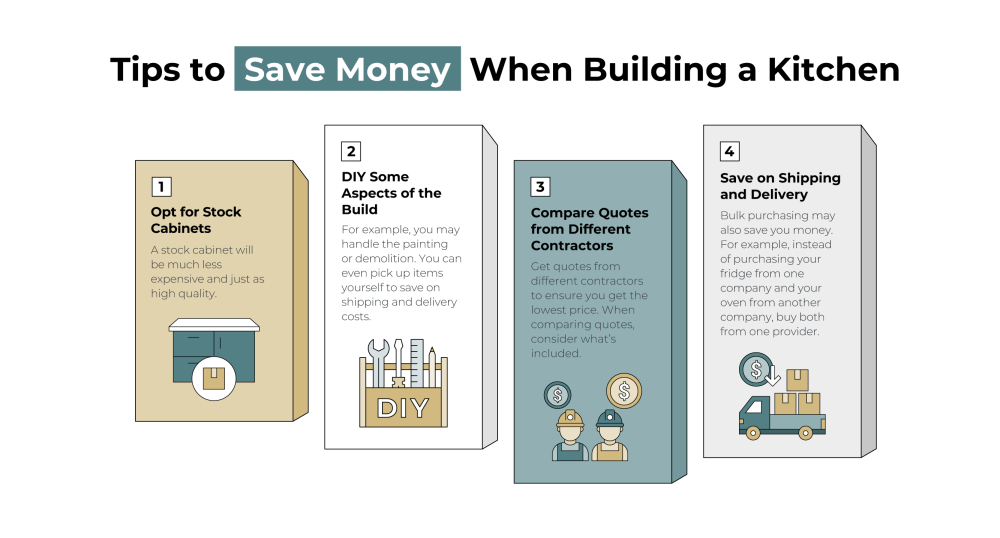
Financing Your Build
Few homeowners have enough money to finance their kitchen build. They must take out loans from financial institutions. Here are some options to consider.
Home Equity Loans and Lines of Credit
A home equity loan allows you to borrow money against the equity you have in your home, i.e., the difference between the market value of your home and the amount you still owe on it. To qualify, you will need at least 20% equity in your home, and a decent credit score typically at least 660. Lenders will also check your income and debt-to-income ratio.
If you qualify, you can choose from a loan or a line of credit. Here are the distinctions.
- Traditional Home Equity Loan: With a traditional loan, you will get a loan amount in one lump sum. You will need to repay the loan on a set schedule over time.
- Home Equity Line of Credit (HELOC): A HELOC works like a credit card. You get approved for a certain amount, and you can borrow from the funds as needed. You can pay back the money right away or over time.
Kitchen Financing Plans Offered by Retailers
Some retailers and contractors work with financial institutions to offer financing plans. They will typically direct you to a website where you can fill out a form to determine if you are approved. If so, you will make payments until the loan is paid off.
There are several things to consider when choosing the loan type and lender that’s right for you. These include:
- APR: The APR includes your fees and interest rates. The lower the better. You should also avoid loans with hefty early repayment and origination fees.
- No Money Down: No money down could be a convenient option as it allows you to get started on your project without any investment. However, if you delay paying off your loan, you could incur steeper interest costs over time.
- Interest Waived: Some loans will waive interest for a limited amount of time allowing you to pay off your loan, or part of your loan, interest-free if possible.
Keep in mind that you may face obstacles when applying for loans if you have a low credit score. It may be difficult to find a lender, and the lenders you find may charge high interest rates. Prepare for your loan by paying off as much debt as possible. You may also look through your credit report for errors that could be bringing down your score.
Another option is to save up for your remodel and take it out of personal savings. This strategy will save you from paying high interest rates. However, it will be difficult to save enough money to cover your remodeling costs.
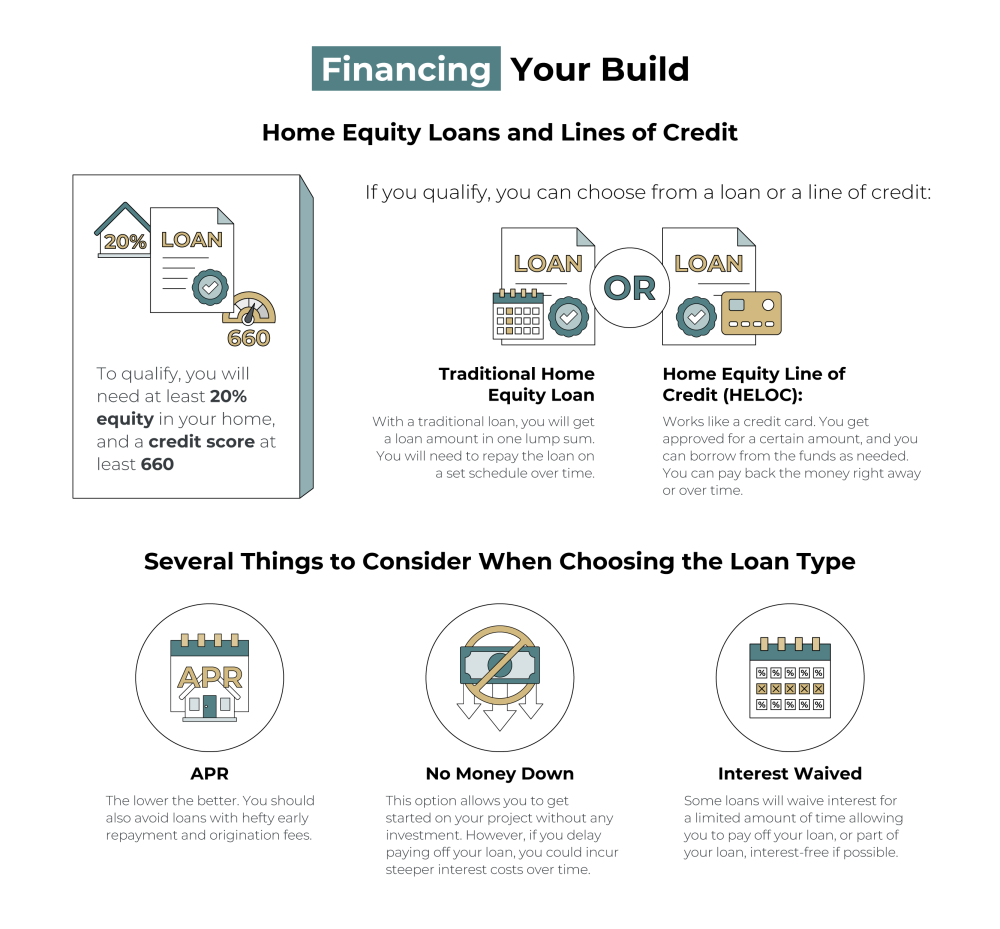
Is it Worth the Investment to Build a Kitchen?
A kitchen build may or may not be worthwhile. Here are some things to consider when determining if a smart move for you.
- Your Budget: Do you have the budget to afford a kitchen remodel?
- Needs: Is your kitchen in such bad shape that you need a remodel?
- ROI: How much will your kitchen remodel increase the value of your home? This question is especially important if you are thinking of selling soon.
Expenses can add up impacting budget and possible ROI, but you can save money by choosing stock items, DIYing some of your project, and comparing different contractor quotes. With the right approach, you will find an affordable way to achieve your dream kitchen.
